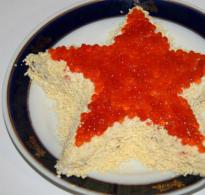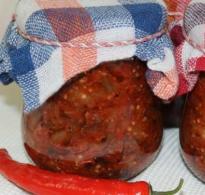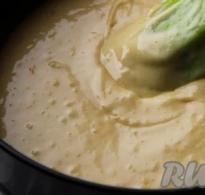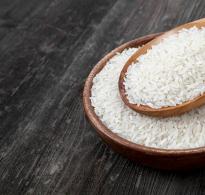How to prepare chutney for winter? Zucchini Chutney What we need for the recipe.
Fragrant, slightly spicy and very tasty chutney (by the way, who can tell me what kind of word “chutney” is, otherwise I’m completely confused))), for now we’ll assume that this is it, then if anything happens, I’ll correct it). A great addition to pork, poultry or rice. You can read about zucchini
Ingredients:
2 onions, chopped
Half a kilo of tomatoes (remove the skin - to do this, place them in boiling water for 2 minutes and chop)
Half a kilo of zucchini (finely chopped)
100 ml white wine vinegar (or fruit vinegar)
2 green sweet and sour apples
250 gr. brown sugar (I only used 50)
2 tablespoons dried herbs (basil, mint, thyme, marjoram)
1 head of garlic
green hot pepper
Fry the garlic and onion in vegetable oil (when they turn a little brown, add salt and sugar)

Add apples there, fry for 2 minutes.


Tomatoes, hot pepper, chopped

Take a saucepan with a thick bottom, or a pot that can be placed on gas. Place chopped tomatoes (without skin), peppers, onions and apples from the pan there.
Separately fry the zucchini (there is no picture - it disappeared somewhere)))
Place fried zucchini in a saucepan. Add vinegar, green pepper, herbs. Simmer for 1-1.5 hours over low heat with the lid open.
Chutney is a seasoning familiar to Indians, designed to enrich the taste of the main dish. Chutney made from hot vegetables and spices is an excellent addition to bland dishes, and thanks to its cheerful colors, it serves as a real decoration for the table. When preparing chutney for the winter, the main thing is not to try to save time. In general, this process takes three to four hours of your life - but the final result will undoubtedly justify the effort!
So, the main secret of perfect chutneys for the winter is to follow only seven basic rules:
1. Use only stainless steel utensils, and stir their contents only with a wooden spoon. All other materials are susceptible to the influence of vinegar, which can cause discoloration of brightly colored fruits.
2. Vegetables and fruits should be cut into the smallest pieces possible - this will allow you to achieve a more uniform consistency of the final product.
 3. Simmer the ingredients in an uncovered saucepan over very low heat, which will also help the chutney develop a more even texture. In addition, slow cooking will make the seasoning more juicy and delicate in taste.
3. Simmer the ingredients in an uncovered saucepan over very low heat, which will also help the chutney develop a more even texture. In addition, slow cooking will make the seasoning more juicy and delicate in taste.
4. Towards the end of cooking, stir the chutney thoroughly to prevent it from sticking to the bottom of the dish.
5. To determine the readiness of the chutney, use the following simple technique: use a wooden spoon to draw a line along the bottom of the saucepan; this narrow strip must be clean before the cooked fruits reoccupy the vacated cavity.
6. When putting the aromatic mass into jars, be sure to leave about half a centimeter to the top. Use lids made of material that does not react with vinegar. Also keep in mind that chutney that is not sealed tightly will dry out quickly.
7. Chutney is best stored in a cool, dry place away from direct light. Before tasting the contents of the jars, it is advisable to let them sit closed for at least 8-10 weeks.
There are many recipes for chutney, but I still prefer the classic version of preparing this winter preparation.
 Classic chutney
Classic chutney
Ingredients: a kilogram of ripe, peeled and diced zucchini (or zucchini), a kilogram of chopped and peeled green tomatoes, 500 grams of apples cut into cubes (also without peel and core), 500 grams of finely chopped onions, 500 grams of sultanas, 60 milliliters of white wine or apple cider vinegar, 2 teaspoons of dry chili pepper (optional), salt to taste.
For the spice bag: 50 grams raw finely chopped ginger root, 2 teaspoons black peppercorns, 1 teaspoon coriander seeds
Cooking method:
1. To make a bag of spices, you should take a small square of muslin with a side of 20 centimeters, put all the above spices in its center and tie its edges with a piece of rope. Next, you need to pour a little water into a saucepan, add all the ingredients of the recipe (including spices) and bring the aromatic mass to a boil over low heat and systematically stirring. After some time, the resulting mixture will noticeably increase in volume, which should be kept in mind when choosing the size of the dish.
2. Next, leave the chutney to simmer slowly for 2.5-3 hours without covering the pan with a lid. Stir the contents of the saucepan from time to time, but there is no need to constantly monitor the progress of cooking. Another sign that the chutney is ready is the thickening of the appetizing mass and the appearance of a characteristic shine. However, in a properly boiled chutney, pieces of vegetables and fruits should still remain clearly visible.
3. Transfer the prepared and slightly cooled chutney into sterilized jars. Press down thoroughly with a wooden spoon to remove air bubbles from the mixture and close tightly with lids. Let me remind you that before opening the jars of seasoning must stand in a cool and dry place for at least a couple of months - the chutney must marinate thoroughly.
Is chutney difficult to make at home? It couldn't be easier! Today we will tell you how to make a delicious Indian zucchini chutney.
What do we need for the recipe?
Ingredients:
- – Zucchini, 250g
- – Apples, 200g
- – Onions, 2-3 pcs.
- – Horseradish root, 25g
- – Sugar, 180g
- - Salt
- – Wine vinegar, 5 tbsp. spoons
- – Dry spices (for example, chili pepper to your taste, hotter or not very hot), 0.5 tsp.
Steps to prepare Indian chutney
- Step 1: Peel zucchini (zucchini), onions and apples and wash thoroughly. Chop coarsely and combine in a saucepan. Add a small amount of water and bring to a boil.
- Step 2: Add salt and sugar, add spices. Grate fresh horseradish root and place in boiling water. Boil over low heat for 15 minutes. After removing the pan from the heat, pour in the wine vinegar. Indian zucchini chutney is ready!
Epilogue: Remember that chutney for the winter must be steeped, so to speak, “given the opportunity to get acquainted” with all the ingredients included in it, soak in and.
Therefore, you can eat it no earlier than in a week, or even two. Chutney can be stored quietly in the refrigerator for up to a year. And poured into scalded jars and rolled up, it will delight you much longer.






